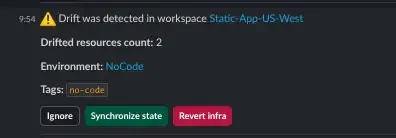Terraform Drift Detection: How to Prevent and Remediate
Learn how to manage Terraform drift, automated drift detection, safe remediation options, and the tools to keep your infrastructure secure.
Infrastructure drift is a critical issue for any team using Terraform. It occurs when the real-world state of your infrastructure no longer matches the configuration defined in your code. This discrepancy can introduce security vulnerabilities, cause application failures, and lead to unexpected costs. This post explains what drift is, how to prevent it, and how Scalr can help you detect, remediate, and report on it.
What is Terraform Drift?
In simple terms, Terraform drift is the difference between your infrastructure's actual state and what your Terraform configuration files say it should be. The state file is Terraform's source of truth, but if changes are made to the infrastructure outside of a Terraform workflow (for example, through a cloud provider's web console), the state file becomes outdated and no longer reflects reality.
Imagine your Terraform code describes an S3 bucket with public access disabled. Then, a developer, in a moment of urgency, logs into the AWS console and manually changes that setting to allow public access. The live infrastructure now differs from your code—that's drift.
This can happen for several reasons:
- Manual Changes: Hotfixes, debugging, or one-off tests done directly in the cloud provider's console.
- Third-Party Automation: Changes made by scripts, a CI/CD pipeline, or other automation tools that are not part of your Terraform workflow.
- Provider Behavior: Cloud providers sometimes change default settings or behaviors without user intervention.
Why is Drift a Problem?
Drift introduces several challenges to infrastructure management. When your infrastructure deviates from its intended state, inconsistencies arise, potentially leading to unexpected and undesirable behavior. This can also create security vulnerabilities, as manual changes might bypass established security protocols. Ultimately, managing and updating an infrastructure becomes significantly more complex when its actual state doesn't align with its Terraform configuration, hindering operational efficiency.
How Drift Happens and How to Prevent It
Drift is often the result of manual changes. Common scenarios include:
- Emergency Fixes: A security engineer might manually update a firewall rule to address an immediate threat.
- Testing and Debugging: A developer could temporarily scale up a resource to test performance and forget to revert the change.
- Lack of Access: A team member without Terraform access might make a change through the cloud provider's UI.
To be proactive and prevent drift, teams should:
- Enforce GitOps: All infrastructure changes should be initiated through a pull request and reviewed before being applied. This creates an audit trail and ensures all changes are codified.
- Restrict Manual Access: Limit who can make manual changes in your cloud environment. Use Role-Based Access Control (RBAC) to enforce the principle of least privilege.
- Implement Continuous Checks: Regularly schedule drift detection to catch any unauthorized changes quickly.
Of course. Here is a comprehensive blog post designed to be a top-ranking resource for the keyword "Terraform drift detection." It is structured to be educational and vendor-neutral, providing a strong foundation before touching on tooling.
How to Detect Drift with Native Terraform Commands
The good news is that Terraform has built-in features to help you detect drift. The primary command you'll use is terraform plan.
The Terraform Plan Command
The terraform plan command is your first line of defense. When you run it, Terraform performs a four-step process:
- Refreshes the State: It reaches out to your cloud provider to query the actual state of all resources defined in your configuration.
- Compares States: It compares the current state of your resources with what's recorded in your
.tfstatefile and what's defined in your.tffiles. - Generates an Execution Plan: It outlines the changes that would be necessary to bring the live infrastructure in line with your configuration.
- Reports on Drift: The output will tell you exactly what changes it plans to make. Any changes it proposes to apply to existing resources are a direct indication of drift.
Example of Detecting Drift:
Let's say your Terraform code defines an S3 bucket with no versioning, but a team member manually enabled it in the AWS console.
Running terraform plan would produce output similar to this:
An execution plan has been generated and is shown below.
Resource actions are indicated with the following symbols:
~ update in-place
Terraform will perform the following actions:
# aws_s3_bucket.example will be updated in-place
~ resource "aws_s3_bucket" "example" {
id = "my-example-bucket"
tags = {
"Name" = "MyBucket"
}
# (10 unchanged attributes hidden)
~ versioning {
~ enabled = false -> true
}
}
Plan: 0 to add, 1 to change, 0 to destroy.
The ~ symbol and the versioning attribute change clearly indicate that drift has occurred. Terraform has detected that the live infrastructure now has versioning enabled, which is not what's in your configuration.
Using Terraform Refresh
While terraform plan implicitly performs a refresh, you can also run terraform refresh as a standalone command. This command updates your state file to reflect the real-world state of your resources without making any changes to your infrastructure. It's a useful way to bring your state file up to date before running a plan.
Native Commands Fall Short
While terraform plan is a powerful tool, it has limitations, especially in large-scale environments:
- Requires Manual Execution: You have to remember to run it regularly and on every part of your infrastructure. This is not scalable.
- Only Checks Managed Resources: It cannot detect resources that exist in your cloud but are not managed by Terraform (i.e., they are not in your state file).
- No Centralized View: The output is local to your terminal. There is no central dashboard or notification system to alert your team of drift.
This is where Terraform TACOs helps teams manage drift at scalr.
How Scalr Detects Drift
Note: Scalr does not charge for drift runs, and the drift feature is included on all tiers.
Scalr has a built-in, automated drift detection feature. You can enable it at the environment level and schedule it to run as frequently as you need. When a drift check runs, Scalr compares the current state of your infrastructure with the last known good state from your Terraform code. If any discrepancies are found, Scalr flags the workspace as "drifted."

Remediation Options
When drift is detected, Scalr provides several options for remediation. We believe in a user-controlled approach rather than automatic remediation, because auto-remediation can be risky. An automatic rollback could unintentionally discard a critical, emergency change.

Scalr empowers you with the following choices:
- Ignore: If the change was intentional, you can simply acknowledge and ignore the drift.
- Sync State: For expected changes, you can sync the state file. This updates your code to match the new reality, bringing your infrastructure back into alignment with your configuration.
- Revert Infrastructure: For unauthorized changes, Scalr can generate a plan to revert the infrastructure to its last known good configuration. You can review this plan and then approve its application.
Drift Notifications
Immediate awareness is key to managing drift. Scalr integrates directly with Slack to send real-time notifications whenever drift is detected. These alerts are sent to a designated channel, ensuring that the right team members are immediately informed of any unauthorized changes to your infrastructure.


Drift Reports
Visibility is crucial for managing drift at scale. Scalr allows you to build comprehensive drift reports through its operational dashboards. These dashboards can be configured at both the account and environment levels.

You can create a custom view that filters to show only workspaces with drift. This gives you a quick, at-a-glance report of all drifted resources across your organization. From this central dashboard, you can drill down into specific workspaces to investigate the drift and decide on the appropriate remediation action. This reporting capability helps platform and security teams maintain a constant watch over the state of their infrastructure.
It also gives visibility into when the last drift was executed, when the next run is scheduled, and options to remediate.
Drift Reports for Platform Teams
For platform engineering teams, Terraform drift reports are not just a useful tool; they are essential for governance and oversight. While these teams may not execute daily terraform apply commands, they are ultimately responsible for the stability, security, and cost-effectiveness of the entire cloud estate. Terraform drift reports provide a high-level, aggregate view of infrastructure health, allowing platform engineers to identify which teams or workspaces are consistently deviating from their codified configurations. This visibility is critical for enforcing best practices, identifying potential security risks from unmanaged resources, and understanding the true state of the infrastructure without having to inspect individual pipelines or workspaces.
This is why Scalr built a "stale workspace" report, which includes drift as well. If you're doing proper GitOps, then you likely want your Terraform workspaces executing runs more often than not. The stale workspace report highlights workspaces that have not had a run executed in 7, 14, 30, 60, or 90 days. From the report, platform teams can execute runs to determine the actual state of the infrastructure to ensure there is no drift, security vulnerabilities, or unwanted costs:

Scalr Drift Demo
More of a visual learner? Check out this short demo of drift detection in Scalr:
Open Source Options
Prefer to use an open-source tool for drift detection? Check out the following options in the market:
driftctl
Developed by Snyk, driftctl is a command-line tool that scans your cloud environments (AWS, GCP, Azure, and GitHub) and compares the actual state of resources with your Terraform state files. It is designed to detect, track, and alert on drift, specializing in identifying unmanaged resources—those that exist in your cloud account but are not tracked in your IaC. This helps you increase your code coverage and spot potential security blind spots.
OpenTofu
OpenTofu is an open-source fork of Terraform and serves as a drop-in replacement, meaning it has the same core drift detection capabilities. By running the tofu plan command, you can see a proposed execution plan that highlights any differences between your configuration files and the infrastructure's current state. While this requires manual execution or simple scripting for automation, it is a fundamental and widely-used method for identifying drift directly within the IaC workflow.

